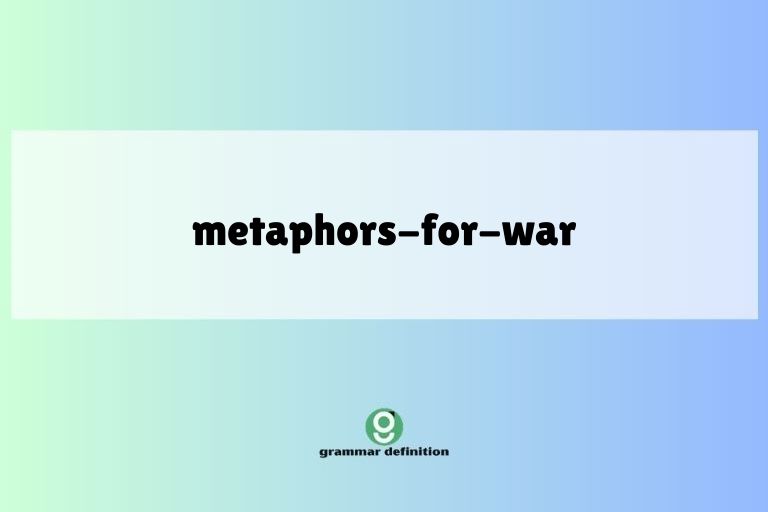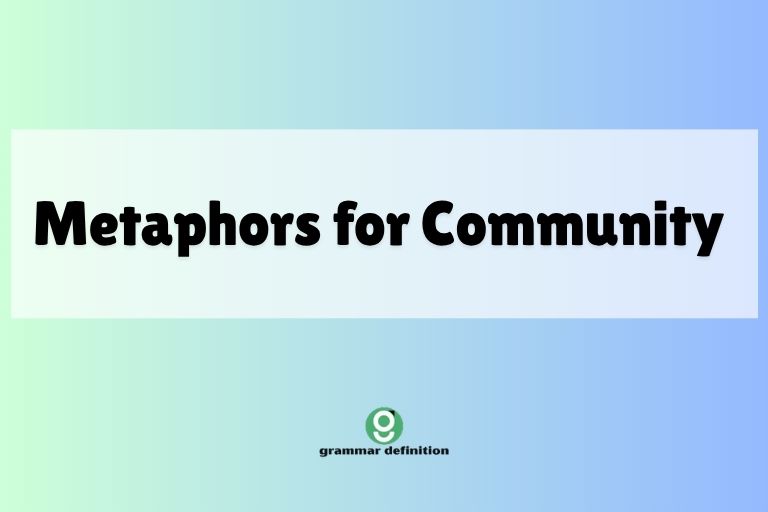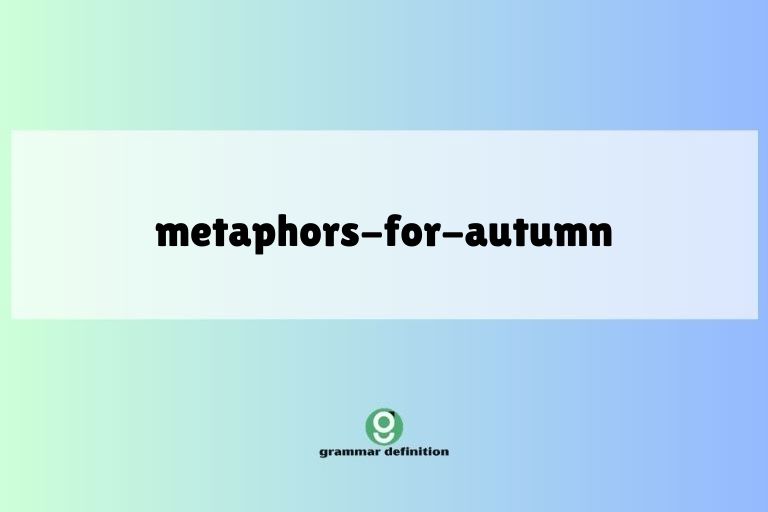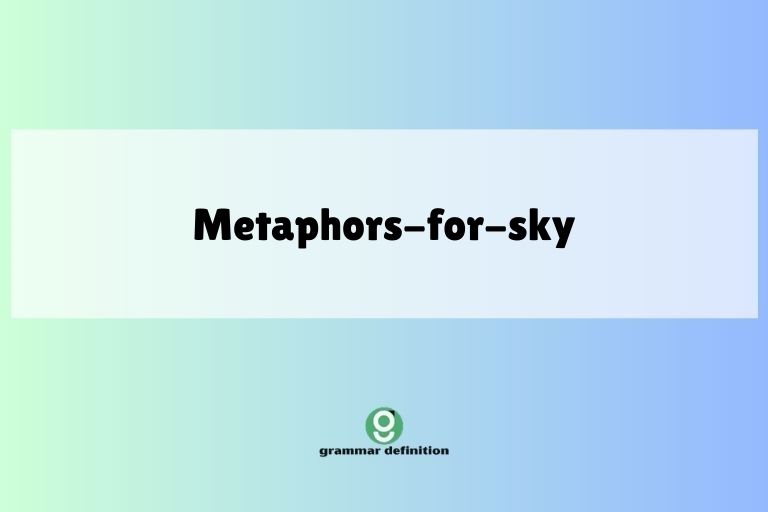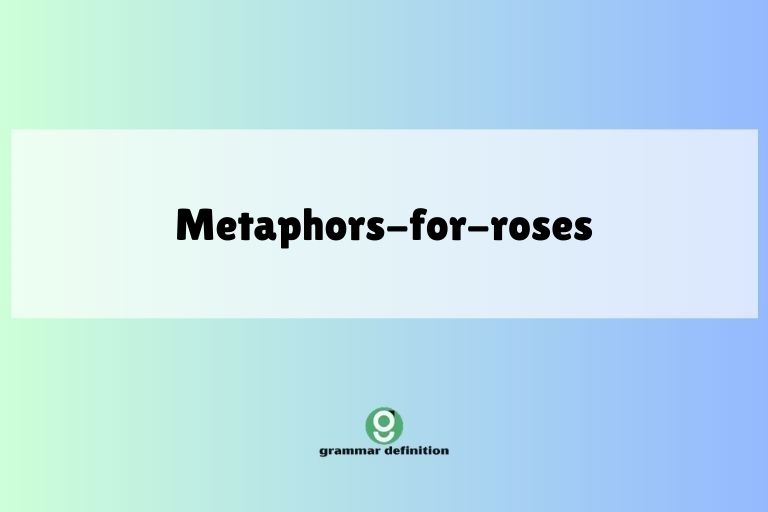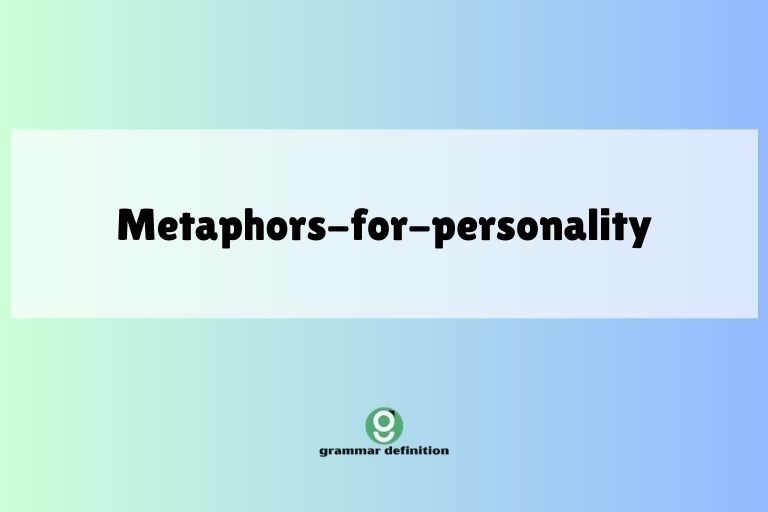Metaphors for Chaos: A Grammatical Exploration
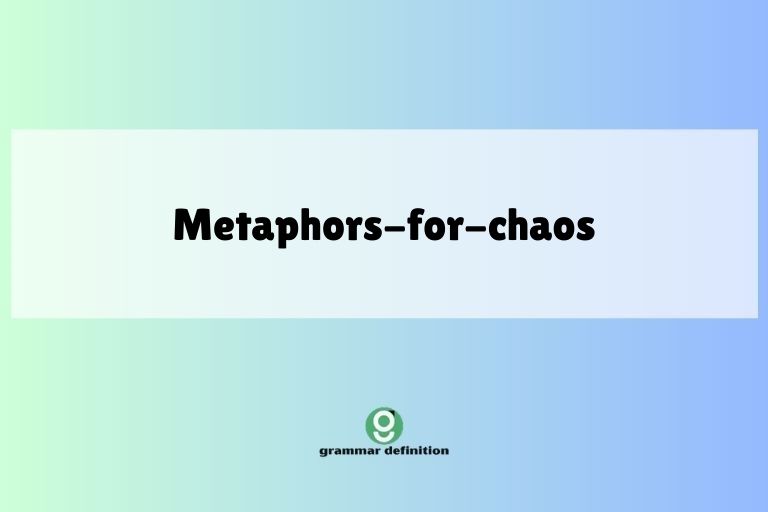
Understanding how we use metaphors to describe chaos is crucial for mastering figurative language and enhancing communication skills. Metaphors allow us to convey complex and abstract ideas, such as chaos, in relatable and vivid terms.
This article delves into the grammatical structures and diverse applications of metaphors for chaos, providing a comprehensive guide for English language learners and enthusiasts alike. By exploring numerous examples and practical exercises, you will gain a deeper appreciation for the power and versatility of these linguistic tools, ultimately improving your ability to express yourself with greater clarity and creativity.
Whether you’re a student, writer, or simply someone looking to refine your language skills, this article offers valuable insights and practical techniques to elevate your understanding and usage of metaphors.
Table of Contents
- Introduction
- Definition of Metaphor for Chaos
- Structural Breakdown
- Types and Categories of Metaphors for Chaos
- Examples of Metaphors for Chaos
- Usage Rules
- Common Mistakes
- Practice Exercises
- Advanced Topics
- FAQ
- Conclusion
Definition of Metaphor for Chaos
A metaphor is a figure of speech that directly compares two unrelated things without using “like” or “as.” Its purpose is to create a vivid image or understanding by transferring qualities from one thing (the source) to another (the target). When we speak of “metaphors for chaos,” we are referring to comparisons that use familiar, concrete concepts to describe the abstract idea of chaos. Chaos, in this context, refers to a state of complete disorder and confusion. These metaphors help us grasp the complexity and intensity of chaotic situations by relating them to more tangible experiences.
The function of a metaphor for chaos is multifaceted. It can be used to evoke strong emotions, provide a clearer understanding of a complex situation, or add stylistic flair to writing and speech.
By employing metaphors, speakers and writers can effectively communicate the overwhelming nature of chaos, making it more relatable and comprehensible to their audience. Metaphors are prevalent in literature, journalism, everyday conversation, and academic discourse, providing a powerful tool for expressing the multifaceted nature of disorder and unpredictability.
The context in which a metaphor for chaos is used significantly impacts its effectiveness. For instance, describing a political crisis as a “storm” conveys a sense of impending danger and turbulent emotions.
Similarly, depicting personal struggles as an “internal war” highlights the intensity of inner conflict. The appropriateness of a metaphor depends on the specific situation, the intended audience, and the overall tone of the communication.
A well-chosen metaphor can resonate deeply, while an inappropriate one can confuse or alienate the audience.
Structural Breakdown
The structure of a metaphor involves two primary elements: the tenor and the vehicle. The tenor is the subject to which metaphorical attributes are ascribed (in this case, chaos). The vehicle is the object whose attributes are borrowed (e.g., a storm, a battlefield, a tangled web). Understanding this structure helps in both analyzing existing metaphors and creating new ones.
The basic pattern is: Chaos is [vehicle]. For example: “The meeting was a circus.” Here, “meeting” (representing a chaotic situation) is the tenor, and “circus” is the vehicle, implying that the meeting was disorganized, unpredictable, and perhaps even amusingly absurd. The effectiveness of the metaphor lies in the shared associations between the vehicle and the tenor.
A more complex metaphor can also include ground, which refers to the shared characteristics or associations between the tenor and the vehicle. In the example above, the ground might include elements like lack of control, unexpected events, and diverse participants. Identifying the ground clarifies the connection between the tenor and vehicle, enhancing the metaphor’s impact. Recognizing these elements is crucial for constructing meaningful and impactful metaphors that effectively communicate the chaotic nature of a given subject.
Metaphors can also be extended, meaning that the comparison is developed over several sentences or even paragraphs. This allows for a more nuanced and detailed exploration of the chaotic situation.
Extended metaphors can be especially powerful in literature and persuasive writing, allowing the writer to build a strong and lasting impression on the reader. Effective metaphors can transform abstract concepts into something tangible, making them more accessible and easier to understand.
The careful selection and construction of metaphors are essential for creating vivid and meaningful communication.
Types and Categories of Metaphors for Chaos
Metaphors for chaos can be categorized based on the types of vehicles used to represent disorder. These categories help to understand the different facets of chaos and how they can be described metaphorically.
Natural Disasters
This category employs natural disasters such as storms, earthquakes, and floods to represent chaotic situations. These metaphors evoke a sense of overwhelming force and unpredictable destruction.
They are often used to describe events that are sudden, catastrophic, and beyond human control. For example, a political scandal might be described as a “political earthquake,” highlighting its disruptive and transformative impact.
War and Conflict
Metaphors in this category use the imagery of war, battles, and conflicts to depict chaos. They emphasize the presence of opposing forces, intense struggle, and potential for casualties.
These metaphors are often used to describe situations involving competition, disagreement, and power struggles. Describing a debate as a “battle of wits” conveys the intensity and adversarial nature of the exchange.
Internal Turmoil
This type of metaphor focuses on the inner chaos experienced by individuals. It often involves images of storms, battles, or tangled webs to represent emotional or psychological distress.
These metaphors highlight the confusion, anxiety, and internal conflict that can accompany personal struggles. For instance, describing one’s mind as a “stormy sea” illustrates the turbulent and overwhelming nature of their thoughts and emotions.
Social and Political Upheaval
These metaphors describe chaos within societies and political systems. They often use images of revolutions, riots, and collapsing structures to represent instability and disorder.
These metaphors highlight the widespread disruption and potential for radical change that can accompany social or political crises. An example would be calling a period of significant social change a “cultural volcano,” emphasizing the explosive and transformative nature of the upheaval.
Abstract Concepts
This category employs abstract concepts like mazes, labyrinths, and puzzles to represent chaos. These metaphors emphasize the complexity, confusion, and difficulty in navigating a chaotic situation.
They are often used to describe problems that are intricate and difficult to solve. Describing a complex legal case as a “labyrinth of legal jargon” highlights the confusing and convoluted nature of the proceedings.
Examples of Metaphors for Chaos
The following sections provide extensive examples of metaphors for chaos, categorized by the types discussed above. These examples illustrate the diverse ways in which metaphors can be used to describe and understand chaos in various contexts.
Natural Disasters Examples
This table presents examples of metaphors using natural disasters to describe chaos. Each example includes the metaphor and a brief explanation of its meaning.
| Metaphor | Explanation |
|---|---|
| The project became a tsunami of unexpected problems. | The project was overwhelmed by a sudden and massive influx of issues. |
| Her emotions were a hurricane of grief and anger. | Her feelings were intense, destructive, and uncontrollable. |
| The company faced a financial earthquake after the scandal. | The company experienced a sudden and devastating financial crisis. |
| The rumor spread like a wildfire through the office. | The rumor spread rapidly and uncontrollably, causing widespread disruption. |
| The debate turned into a volcano of heated arguments. | The debate erupted with intense and uncontrollable disagreements. |
| The market crash was a blizzard of selling activity. | The market was overwhelmed by a sudden and intense wave of selling. |
| The meeting was a mudslide of irrelevant information. | The meeting was overwhelmed by a chaotic and overwhelming amount of information. |
| The new policy was met with a thunderstorm of criticism. | The policy was met with a sudden and intense wave of disapproval. |
| His life felt like a shipwreck after losing his job. | His life was in ruins and filled with despair after the job loss. |
| The news created a whirlwind of speculation. | The news triggered a rapid and chaotic spread of rumors and guesses. |
| The team’s performance was a drought of creativity. | The team’s performance lacked any innovative or imaginative ideas. |
| The investigation uncovered a sinkhole of corruption. | The investigation revealed a deep and hidden source of corruption. |
| The merger turned into a glacial process of negotiations. | The merger negotiations were extremely slow and arduous. |
| The city became a furnace of political unrest. | The city was filled with intense and escalating political tensions. |
| Her mind was a fog of confusion and uncertainty. | Her thoughts were unclear and she felt disoriented. |
| The project’s timeline was a sandstorm of missed deadlines. | The project was plagued by numerous and frequent missed deadlines. |
| The announcement was a tidal wave of public interest. | The announcement generated an overwhelming surge of public attention. |
| His temper was a lightning strike of sudden rage. | His anger appeared suddenly and intensely. |
| The budget cuts were a landslide of financial hardship. | The budget cuts caused widespread and significant financial difficulties. |
| The political climate was a heatwave of tension and anxiety. | The political climate was extremely tense and filled with anxiety. |
| The presentation was a monsoon of information, overwhelming the audience. | The presentation delivered so much information that the audience was overwhelmed by the sheer volume. |
| The scandal ripped through the community like a tornado, leaving devastation in its wake. | The scandal quickly and destructively impacted the community, causing widespread damage and distress. |
| The economic crisis was a tectonic shift, reshaping the entire industry. | The economic crisis caused fundamental and far-reaching changes across the industry. |
War and Conflict Examples
This table provides examples of metaphors using war and conflict to describe chaotic situations. Each example includes the metaphor and its explanation.
| Metaphor | Explanation |
|---|---|
| The office was a battlefield during the merger. | The office was a place of intense competition and conflict. |
| The negotiation became a war of attrition. | The negotiation was a prolonged and exhausting struggle. |
| Her mind was a war zone of conflicting thoughts. | Her thoughts were in constant conflict and turmoil. |
| The project was a minefield of potential problems. | The project was filled with hidden and dangerous risks. |
| The debate turned into a skirmish of personal attacks. | The debate devolved into brief and heated exchanges of insults. |
| The boardroom became a theater of war. | The boardroom was the setting for intense and strategic battles. |
| The company was engaged in a corporate raid. | The company was the target of a hostile takeover attempt. |
| His career was a struggle against constant setbacks. | His career was marked by continuous efforts to overcome obstacles. |
| The political landscape was a quagmire of conflicting interests. | The political situation was complex, confusing, and difficult to navigate. |
| The discussion escalated into a verbal assault. | The discussion turned into an aggressive and hostile exchange of words. |
| The project was a siege against tight deadlines. | The project involved a prolonged and intense effort to meet the deadlines. |
| The argument became a bombardment of accusations. | The argument involved a relentless and overwhelming stream of accusations. |
| Her life felt like a guerrilla war against her own insecurities. | Her life was a constant struggle against her own internal doubts and fears. |
| The company faced a barrage of lawsuits. | The company was hit with a sudden and overwhelming number of legal actions. |
| The team was locked in a trench warfare of slow progress. | The team was engaged in a grueling and slow-moving effort with minimal progress. |
| The political campaign was a dogfight of personal attacks. | The political campaign was characterized by fierce and often negative competition. |
| The negotiation was a chess match of strategic moves. | The negotiation involved careful planning and strategic maneuvering. |
| The industry was a survival of the fittest environment. | The industry was highly competitive, where only the strongest companies could survive. |
| His attempt to climb the corporate ladder was a bloody battle. | His career advancement was challenging and involved intense competition. |
| The merger talks dissolved into a hostile standoff. | The merger negotiations broke down and resulted in a tense and adversarial situation. |
| The project was a constant tug-of-war between different departments. | The project involved ongoing conflicts and disagreements between various departments. |
| Navigating the bureaucracy was like traversing a no man’s land. | Dealing with the bureaucracy felt like navigating a dangerous and uncertain territory. |
| The company was in a state of siege, fending off competitors and economic pressures. | The company was under constant pressure and attack from competitors and economic challenges. |
Internal Turmoil Examples
This table illustrates metaphors using internal turmoil to describe chaos within an individual. Each example includes the metaphor and its explanation.
| Metaphor | Explanation |
|---|---|
| Her thoughts were a tangled web of confusion. | Her thoughts were complicated, interconnected, and difficult to untangle. |
| His mind was a roller coaster of emotions. | His emotions fluctuated rapidly and unpredictably. |
| She felt like a ship lost at sea, without direction. | She felt disoriented, lost, and without a clear sense of purpose. |
| His heart was a broken record, repeating the same pain. | He was constantly reliving the same painful experiences. |
| Her soul was a dark forest of despair. | She felt lost and overwhelmed by feelings of sadness and hopelessness. |
| His conscience was a stormy sea of guilt. | He was tormented by feelings of remorse and wrongdoing. |
| She felt like a puppet on strings, controlled by her anxiety. | She felt powerless and manipulated by her own anxiety. |
| His life was a jigsaw puzzle with missing pieces. | His life felt incomplete and lacking essential elements. |
| Her emotions were a pressure cooker about to explode. | Her emotions were building up to an overwhelming point. |
| His mind was a circus of distracting thoughts. | His thoughts were chaotic, disorganized, and difficult to focus on. |
| She felt like a trapped bird, longing for freedom. | She felt confined and desperate to escape her current situation. |
| His heart was a battleground of conflicting desires. | He was torn between opposing desires and impulses. |
| Her life felt like a maze with no exit. | She felt trapped in a complex and confusing situation with no clear solution. |
| His emotions were a rollercoaster of highs and lows. | His feelings fluctuated rapidly between happiness and sadness. |
| She felt like a leaf in the wind, blown about by circumstances. | She felt powerless and easily influenced by external factors. |
| His mind was a house on fire, consumed by worry. | He was overwhelmed and consumed by anxiety and stress. |
| Her soul was a shattered mirror, reflecting broken images. | She felt fragmented and damaged, with a distorted sense of self. |
| His heart was a locked box, hiding deep emotions. | He was guarded and unwilling to express his true feelings. |
| Her mind was a cacophony of voices, each clamoring for attention. | She was overwhelmed by a jumble of competing thoughts and ideas. |
| He felt like a tightrope walker, constantly balancing on the edge of disaster. | He felt precariously close to failure and constantly stressed by the need to maintain control. |
| Her spirit was a flickering candle, struggling to stay alight in the darkness. | Her sense of hope and resilience was fragile and threatened by difficult circumstances. |
| His emotions were a boiling cauldron, ready to overflow at any moment. | He was experiencing intense and volatile feelings that were on the verge of erupting. |
Social and Political Upheaval Examples
This table features metaphors using social and political upheaval to describe chaos within larger systems. Each example includes the metaphor and its explanation.
| Metaphor | Explanation |
|---|---|
| The government was a house of cards, ready to collapse. | The government was unstable and vulnerable to failure. |
| The revolution was a cultural earthquake. | The revolution caused a profound and disruptive transformation of society. |
| The city was a powder keg of social unrest. | The city was filled with pent-up anger and frustration, ready to explode into violence. |
| The political climate was a storm brewing on the horizon. | The political situation was tense and foreshadowed potential conflict. |
| The society was a boiling pot of diverse opinions. | The society was filled with a mixture of conflicting viewpoints and tensions. |
| The system was a ticking time bomb of economic inequality. | The system contained underlying issues that threatened to cause a major crisis. |
| The country was a ship without a rudder, drifting aimlessly. | The country lacked leadership and direction, leading to uncertainty and instability. |
| The political debate was a circus of absurd arguments. | The political debate was chaotic, disorganized, and often ridiculous. |
| The economy was a roller coaster of booms and busts. | The economy experienced rapid and unpredictable cycles of growth and decline. |
| The society was a pressure cooker of social tensions. | The society was filled with escalating tensions that threatened to erupt into conflict. |
| The government was a maze of bureaucratic red tape. | The government was complex, confusing, and difficult to navigate. |
| The political landscape was a battlefield of competing ideologies. | The political arena was characterized by intense conflict between different belief systems. |
| The social fabric was a tangled web of interconnected issues. | The society faced a complex and intertwined set of problems. |
| The country was a house divided, torn by internal conflicts. | The nation was deeply divided by disagreements and tensions. |
| The revolution was a wildfire spreading through the country. | The revolution spread rapidly and uncontrollably, affecting all parts of the nation. |
| The political system was a swamp of corruption. | The political system was deeply corrupt and morally compromised. |
| The society was a melting pot of different cultures and traditions. | The society was a diverse mix of various cultural backgrounds and customs. |
| The political discourse was a cesspool of negativity and misinformation. | The political conversation was filled with harmful and misleading content. |
| The legal system became a labyrinth, ensnaring the innocent and freeing the guilty. | The legal system was perceived as complex and unfair, leading to unjust outcomes. |
| The economic recession was a black hole, sucking the life out of businesses and communities. | The economic downturn had a devastating and far-reaching impact, causing widespread hardship. |
| The political scandal was a pandemic, infecting every level of the government. | The scandal spread rapidly and extensively, affecting many parts of the government. |
| The social media landscape was a toxic waste dump, filled with hate and misinformation. | Social media was perceived as harmful and dangerous due to the prevalence of negativity and false information. |
Abstract Concepts Examples
This table provides examples of metaphors using abstract concepts to describe chaos. Each example includes the metaphor and its explanation.
| Metaphor | Explanation |
|---|---|
| The situation was a perfect storm of unfortunate events. | The situation was the result of a rare and disastrous combination of factors. |
| The project was a house of cards, ready to collapse at any moment. | The project was fragile and easily susceptible to failure. |
| The plan was a tangled web of dependencies. | The plan was complex, interconnected, and difficult to manage. |
| The problem was a Pandora’s box of unforeseen consequences. | The problem unleashed a series of unexpected and negative outcomes. |
| The relationship was a roller coaster of ups and downs. | The relationship experienced frequent and unpredictable changes in emotional intensity. |
| The issue was a can of worms that no one wanted to open. | The issue was complex and likely to create further problems if addressed. |
| The process was a labyrinth of bureaucratic procedures. | The process was complex, confusing, and difficult to navigate. |
| The company was a circus of incompetence. | The company was disorganized, chaotic, and marked by a lack of skill. |
| The meeting was a train wreck of miscommunication. | The meeting was a complete disaster due to poor communication. |
| The situation was a black hole of wasted resources. | The situation consumed a large amount of resources without producing any positive results. |
| The decision was a slippery slope towards disaster. | The decision was likely to lead to a series of increasingly negative consequences. |
| The project was a juggling act of competing priorities. | The project involved balancing multiple conflicting demands. |
| The situation was a domino effect of cascading failures. | The situation involved a series of failures, each triggering the next. |
| The problem was a puzzle with missing pieces. | The problem was incomplete and difficult to solve. |
| The situation was a pressure cooker of escalating tensions. | The situation was filled with increasing stress and potential for conflict. |
| The process was a marathon of endurance and perseverance. | The process was lengthy and required sustained effort. |
| The project was a house of cards waiting to collapse. | The project was fragile and easily susceptible to failure. |
| The market was a casino of speculation and risk. | The market was unpredictable and involved high levels of risk. |
| His life was a soap opera of constant drama. | His life was filled with exaggerated and melodramatic events. |
| The debate was a ping-pong match of back-and-forth arguments. | The debate involved a rapid exchange of opposing viewpoints. |
| The conference was a three-ring circus with multiple events happening simultaneously. | The conference was overwhelming and chaotic due to the numerous concurrent activities. |
| The company’s strategy was a shot in the dark, with little chance of success. | The company’s strategy was highly speculative and unlikely to achieve the desired outcome. |
| The project became a black swan event, an unpredictable surprise with significant consequences. | The project experienced an unexpected and impactful event that drastically changed its trajectory. |
Usage Rules
When using metaphors for chaos, there are several rules to keep in mind to ensure clarity and impact. First, the metaphor should be relevant to the context. The vehicle should have clear and understandable associations with the tenor (chaos). A metaphor that is too obscure or unrelated will confuse the audience rather than enlighten them.
Second, the metaphor should be consistent. Avoid mixing metaphors within the same sentence or paragraph, as this can create a confusing and jarring effect. For example, avoid saying “The project was a rollercoaster heading for a minefield,” as it combines two different metaphors (rollercoaster and minefield) that clash with each other. Instead, maintain a single, coherent image throughout the description.
Third, the metaphor should be original and fresh, if possible. Overused metaphors (clichés) can lose their impact and become dull. Strive to create new and imaginative comparisons that will capture the audience’s attention and provide a unique perspective on the chaotic situation. While some common metaphors are effective due to their widespread understanding, a novel metaphor can be more impactful.
Fourth, consider the emotional tone of the metaphor. The vehicle should evoke the appropriate emotions in the audience. For example, if you want to convey a sense of danger and urgency, use metaphors that involve threats or disasters. If you want to highlight the absurdity of the situation, use metaphors that involve humor or irony. Metaphors have the power to elicit emotional responses, so choose vehicles that align with the desired tone.
Finally, ensure the metaphor is grammatically correct within the sentence. The metaphor should fit seamlessly into the sentence structure and not create any grammatical errors or awkward phrasing. Pay attention to verb tenses, subject-verb agreement, and the overall flow of the sentence. A grammatically sound metaphor will enhance the clarity and impact of your writing or speech.
Common Mistakes
One common mistake is using mixed metaphors. This occurs when two or more inconsistent metaphors are combined, creating a confusing or nonsensical image. For example:
Incorrect: The project was a runaway train that needed to nip it in the bud.
This sentence combines the metaphor of a runaway train (implying something out of control) with the idiom “nip it in the bud” (implying stopping something early). These images don’t blend well.
A correct version might be:
Correct: The project was a runaway train, gaining speed and heading for disaster.
Another common mistake is using clichéd metaphors. These are overused metaphors that have lost their impact due to overuse. While they may be easily understood, they lack originality and can make your writing or speech sound uninspired. For example:
Clichéd: The situation was a perfect storm.
A more original alternative could be:
Original: The situation was a convergence of unfortunate events, each amplifying the others.
A third mistake is using metaphors that are too literal or lack a clear connection to the tenor. The vehicle should have a strong and understandable association with chaos. If the connection is too weak or unclear, the metaphor will fail to convey the intended meaning. For example:
Unclear: The meeting was a pineapple.
This metaphor lacks a clear connection to chaos. A better metaphor might be:
Clear: The meeting was a circus of conflicting agendas and disorganized discussions.
Another error is the misuse of simile as metaphor. Similes use “like” or “as” to make comparisons, while metaphors directly equate two things. Using “like” or “as” in a sentence intended as a metaphor weakens the impact. For example:
Incorrect: The project was like a train wreck.
Correct: The project was a train wreck.
Finally, using metaphors that are culturally insensitive or inappropriate for the audience is a serious mistake. Be mindful of the potential impact of your metaphors and avoid using vehicles that could be offensive or alienating to certain groups. Consider the cultural background and values of your audience when selecting metaphors.
Practice Exercises
Test your understanding of metaphors for chaos with these exercises. Identify the metaphor in each sentence and explain its meaning.
Then, rewrite each sentence using a different metaphor for chaos.
| Question | Answer |
|---|---|
| 1. The company’s finances were a house of cards, ready to collapse. | Metaphor: House of cards. Meaning: The company’s finances were unstable and vulnerable. Alternative: The company’s finances were a ticking time bomb, threatening to explode. |
| 2. Her mind was a tangled web of anxieties and fears. | Metaphor: Tangled web. Meaning: Her thoughts were complex and difficult to untangle. Alternative: Her mind was a stormy sea of anxieties and fears. |
| 3. The political debate was a circus of absurd arguments and personal attacks. | Metaphor: Circus. Meaning: The debate was chaotic, disorganized, and ridiculous. Alternative: The political debate was a battlefield of absurd arguments and personal attacks. |
| 4. The project became a runaway train, speeding towards disaster. | Metaphor: Runaway train. Meaning: The project was out of control and heading for failure. Alternative: The project became a tsunami of unexpected problems, overwhelming the team. |
| 5. The economy was a roller coaster of booms and busts. | Metaphor: Roller coaster. Meaning: The economy experienced rapid and unpredictable
changes. Alternative: The economy was a turbulent sea, with unpredictable waves of booms and busts. |
Exercise 2: Create your own metaphors for the following situations:
- A chaotic family gathering.
- A disorganized office space.
- A confusing legal document.
- A turbulent romantic relationship.
- A period of rapid technological change.
Example Answer: A chaotic family gathering was a zoo, with relatives squawking and children running wild.
Advanced Topics
For more advanced study, consider exploring the use of extended metaphors. An extended metaphor develops a comparison over several lines or even an entire piece of writing. This technique allows for a more nuanced and detailed exploration of the subject.
Another area to investigate is the use of archetypal metaphors. These are metaphors that draw on universal symbols and patterns of human experience. Examples include the journey, the hero, and the shadow. Archetypal metaphors can add depth and resonance to your writing by tapping into collective unconscious associations.
Also, research the use of metaphor in different cultural contexts. Metaphors are often culturally specific, and what resonates in one culture may not in another. Understanding these differences can help you communicate more effectively with diverse audiences.
Finally, delve into the philosophical implications of metaphor. Metaphor is not just a linguistic device; it is also a way of thinking and understanding the world.
Exploring the philosophical dimensions of metaphor can deepen your appreciation for its power and complexity.
FAQ
What is the difference between a metaphor and a simile?
A metaphor directly compares two unlike things without using “like” or “as,” while a simile uses “like” or “as” to make a comparison. For example: “The meeting was a circus” (metaphor) vs.
“The meeting was like a circus” (simile).
How can I avoid using clichéd metaphors?
Strive for originality by thinking creatively and exploring new and unexpected comparisons. Consider the specific qualities of the tenor (chaos) and look for vehicles that capture those qualities in a fresh and imaginative way.
How do I know if a metaphor is effective?
An effective metaphor should be clear, relevant, and evocative. It should create a vivid image or understanding in the mind of the audience and enhance the overall impact of your writing or speech.
Get feedback from others to see if your metaphors resonate with them.
Can a metaphor be too complex?
Yes, a metaphor can be too complex if it is difficult to understand or requires too much effort to decipher. The vehicle should be familiar enough for the audience to grasp the connection to the tenor.
If the metaphor is too obscure, it will fail to communicate effectively.
How can I improve my ability to create metaphors?
Practice regularly by experimenting with different comparisons and seeking feedback from others. Read widely and pay attention to the metaphors used by skilled writers and speakers.
The more you engage with figurative language, the better you will become at creating your own metaphors.
Conclusion
Metaphors for chaos are powerful tools for expressing complex and abstract ideas in relatable and vivid terms. By understanding the grammatical structures, types, and usage rules of these metaphors, you can enhance your communication skills and express yourself with greater clarity and creativity.
Whether you are a student, writer, or language enthusiast, mastering the art of metaphor will enrich your ability to convey meaning and connect with your audience on a deeper level. Embrace the power of figurative language, and you will unlock new possibilities for expression and understanding.

